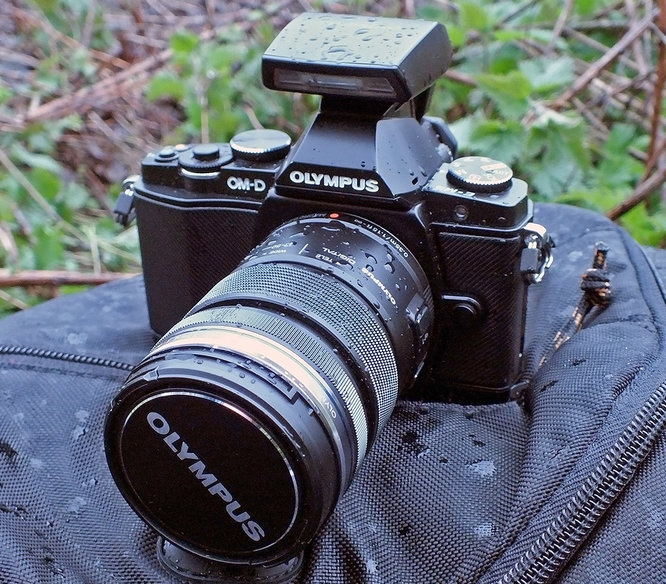Using the Olympus OM-D E-M5 a Two Months Experience

Olympus OM-D E-M5 Micro Four Thirds Compact System Camera
A reviewer at ePhotozine has shared his 2 months user experience of using the Olympus OM-D E-M5 micro four thirds compact system camera . Besides having the black body Olympus OM-D E-M5 the reviewer also has the Olympus 12-50mm kit lens, the Olympus 75-300mm zoom lens, a Olympus ultra-wide zoom 9-18mm lens, and the venerable Olympus 45mm F1.8 lens .
Prior to using the Olympus OM-D E-M5 the reviewer used to have Canon gear mainly the Canon EOS 5D Mk2 and the 60D. Though those cameras are excellent they also come at a cost of being bulky and heavy. So the reviewer was looking for a smaller alternative that seemed to have had appeared upon time of launch of the OM-D E-M5 compact system camera. The camera seemed to be the perfect replacement for the Canon 60D so after trying a Olympus OM-D E-M5 from a friend of his he decided to take the plunge and sell some of his Canon gear plus the 60D and get the Olympus OM-D E-M5 together with some lens.
The reviewer takes a lot of different types of photography covering water sports, macro photography, studio, landscape, flowers, wildlife. To be able to cater for his requirements he purchased then a
- Olympus OM-D E-M5
- Olympus 12-50mm kit lens
- Olympus 75-300mm (used)
- Olympus 9-18mm
- Olympus 45mm f1.8
- Olympus FL36 flash gun (used)
Olympus OM-D E-M5 a lightweight setup
One of the first conclusions of moving from Canon EOS gear to Micro Four Thirds has been the reduction of size and gear weight. With his Canon gear ( Canon EOS 5D Mk2 + 17-55mm L IS + 24-105mm L IS + 100mm L IS macro + 70-300mm L IS) he would have to carry a weight of 3.8Kg while with the Olympus gear ( Olympus OM-D EM-5 + 9-18mm + 12-50mm + 45mm f1.8 + 75-300mm) a total weight of 1.24 Kg.
That is a savings of 2.56Kg meaning reviewer could carry his gear without worrying on injuring his neck or shoulders.
Some of his photography work with his new camera:
From reviewers experiences with camera so far the only problems with his setup is taking photos of birds in flight as the 75-300mm lens is not able to focus quickly in fast moving subjects due to its CDAF focusing methods. A workaround for him has been to use manual focus with better and better results once he started to learn the focusing methods.
Conclusions on using the Olympus OM-D E-M5
The pros and cons of the Olympus OM-D E-M5 so far:
Pros of using the Olympus OM-D E-M5
- Lightweight
- Well made (some of the lenses are built like a watch)
- Comparatively small, even with the battery pack
- EVF is excellent, clear and large enough to compose and manual focus with
- Very fast, accurate AF in SAF mode using center focus point
- The kit lens is excellent value, particularly for close-up & macro work
- A good range of lenses is available
- The ability to use 3rd party / legacy lenses via adapters is a bonus
- Prints from processed RAW images are close to the quality of those I got from my Canon system (tested up to 18″x12″ so far)
- Olympus OM-D E-M5 Menu system is not easy to use
- Buttons are not nice to use, a bit “squidgy” and imprecise feeling
- Continuous AF and Focus Tracking are not well enacted, I’ve stopped using this for my work
- It’s not best suited to shooting Birds in Flight, particularly against light, bright skies
Their conclusion: This has been a most interesting and fun period of my photographic life, first deciding whether to buy into the m4/3rds system via the Olympus OM-D E-M5, then whether I should dispose of my Canon system. I’m happy that I made the right decison and, as others have reported, find that it has brought a sense of fun back into my hobby. It’s not all good news though, I’m still finding the Menu system confusing, the buttons can be a real pain at times (as with the need to “tap” the “fn2″ button to magnify the view) but it’s getting better with use.
Source: http://www.ephotozine.com/article/olympus-om-d-e-m5-2-month-user-review-19855












